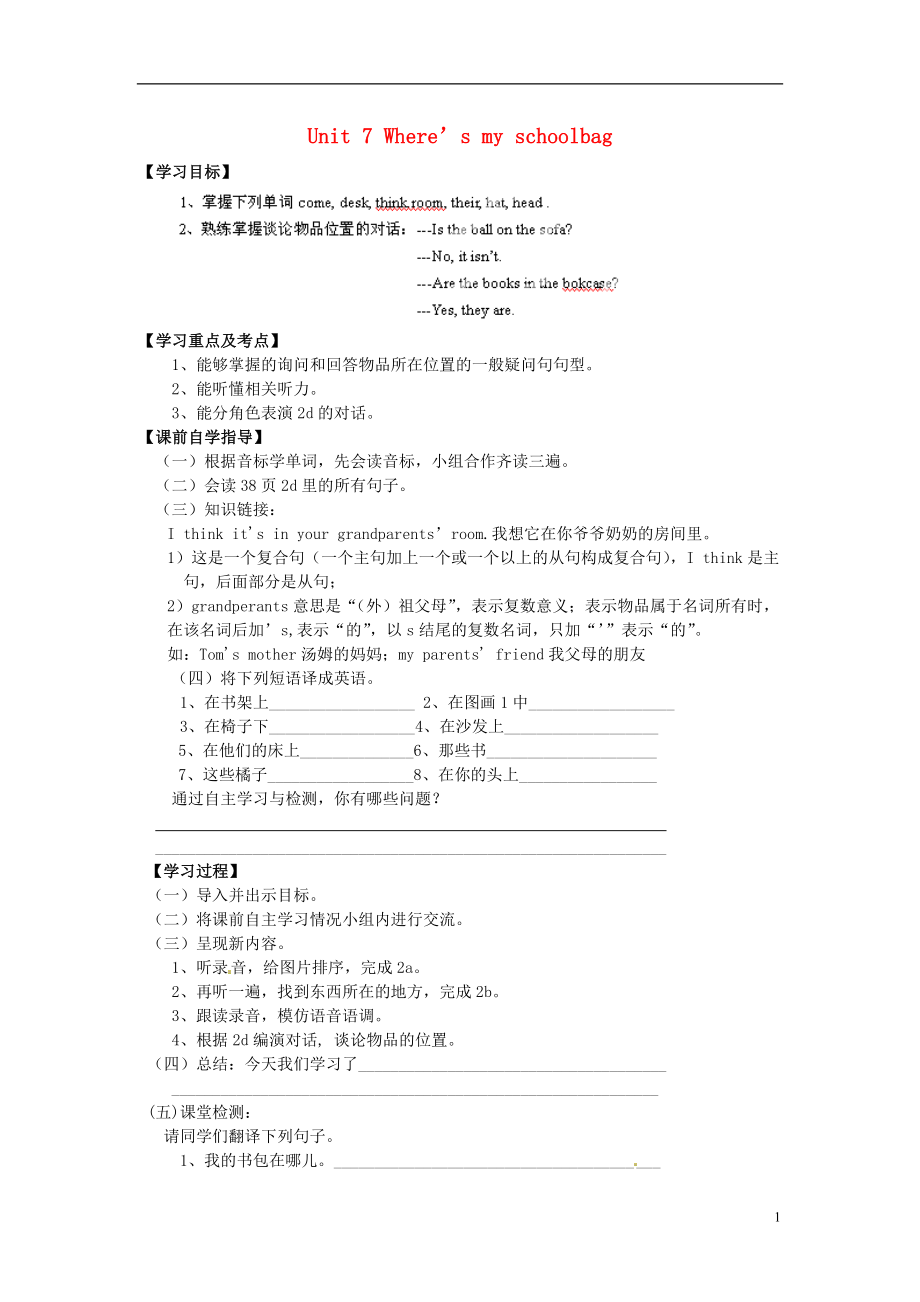《河南省濮陽(yáng)市第六中學(xué)六年級(jí)英語(yǔ)上冊(cè) Unit 7 Where’s my schoolbag Period 2 Section A (2a—2d)導(dǎo)學(xué)案(無(wú)答案) 魯教版五四制》由會(huì)員分享�����,可在線閱讀�����,更多相關(guān)《河南省濮陽(yáng)市第六中學(xué)六年級(jí)英語(yǔ)上冊(cè) Unit 7 Where’s my schoolbag Period 2 Section A (2a—2d)導(dǎo)學(xué)案(無(wú)答案) 魯教版五四制(3頁(yè)珍藏版)》請(qǐng)?jiān)谘b配圖網(wǎng)上搜索。
1�����、
Unit 7 Where’s my schoolbag
【學(xué)習(xí)目標(biāo)】
【學(xué)習(xí)重點(diǎn)及考點(diǎn)】
1�����、能夠掌握的詢(xún)問(wèn)和回答物品所在位置的一般疑問(wèn)句句型�����。
2�����、能聽(tīng)懂相關(guān)聽(tīng)力�����。
3�����、能分角色表演2d的對(duì)話。
【課前自學(xué)指導(dǎo)】
(一)根據(jù)音標(biāo)學(xué)單詞�����,先會(huì)讀音標(biāo)�����,小組合作齊讀三遍�����。
(二)會(huì)讀38頁(yè)2d里的所有句子�����。
(三)知識(shí)鏈接:
I think it's in your grandparents’room.我想它在你爺爺奶奶的房間里�����。
1)這是一個(gè)復(fù)合句(一個(gè)主句加上一個(gè)或一個(gè)以上的從句構(gòu)成復(fù)合句)�����,I think是主句�����,后面部分是從句�����;
2)grandperants
2�����、意思是“(外)祖父母”�����,表示復(fù)數(shù)意義�����;表示物品屬于名詞所有時(shí)�����,在該名詞后加’s,表示“的”�����,以s結(jié)尾的復(fù)數(shù)名詞,只加“’”表示“的”�����。
如:Tom's mother湯姆的媽媽?zhuān)籱y parents' friend我父母的朋友
(四)將下列短語(yǔ)譯成英語(yǔ)�����。
1�����、在書(shū)架上__________________ 2�����、在圖畫(huà)1中__________________
3�����、在椅子下__________________4�����、在沙發(fā)上___________________
5�����、在他們的床上______________6�����、那些書(shū)_____________________
7�����、這些橘子___________
3�����、_______8�����、在你的頭上_________________
通過(guò)自主學(xué)習(xí)與檢測(cè)�����,你有哪些問(wèn)題�����?
_______________________________________________________________
【學(xué)習(xí)過(guò)程】
(一)導(dǎo)入并出示目標(biāo)。
(二)將課前自主學(xué)習(xí)情況小組內(nèi)進(jìn)行交流�����。
(三)呈現(xiàn)新內(nèi)容�����。
1�����、聽(tīng)錄音�����,給圖片排序�����,完成2a�����。
2�����、再聽(tīng)一遍�����,找到東西所在的地方�����,完成2b�����。
3�����、跟讀錄音�����,模仿語(yǔ)音語(yǔ)調(diào)�����。
4、4�����、根據(jù)2d編演對(duì)話, 談?wù)撐锲返奈恢谩?
(四)總結(jié):今天我們學(xué)習(xí)了______________________________________
____________________________________________________________
(五)課堂檢測(cè):
請(qǐng)同學(xué)們翻譯下列句子�����。
1�����、我的書(shū)包在哪兒�����。________________________________________
2�����、它不在椅子下面�����。_______________________________________
3�����、我認(rèn)為它在你奶奶的房間里�����。___________________
5�����、__________
4�����、它在你頭上�����。___________________________________________
5�����、你的鋼筆在桌子里面�����。__________________________________
【課后作業(yè)】
完成節(jié)節(jié)練。
第二課時(shí)節(jié)節(jié)練
一�����、選擇填空�����。
( ) 1.---______your map? –It’s here.
A. Where B. Where are C. Where is D. What’s
( ) 2. Is the pencil case ______the schoolbag?
6�����、 A. in B. on C. at D. to
( ) 3.- --What are those? ---They’re ______
A. a key B. keys C. the keys D. the key
( ) 4. ---Is your photo in the desk? ---________
A. Yes, I am B. Yes, you are C. No, it is D. Yes, it is
( ) 5. ---_____ the key
7�����、s? ---_____ on the bed.
A. Where is, It’s B. Where are, They’re
C. Where’s , They’re D. Where are , It’s
( ) 6.- --Are your pencils in the schoolbag?
---No, _________
A. it’s B. I’m not C. they aren’t D. it isn’t
( ) 7. ---_____ they under the table?
8�����、
A. Is B. Are C. Am D. Where
二�����、從Ⅱ欄中找出與Ⅰ欄相對(duì)應(yīng)的答語(yǔ)�����。
Ⅰ Ⅱ
1. Is that boy your brother? A. No, it isn't.
2. Where is his map? B. OK.
3. Is her photo in the desk? C. They're under the bed.
4. Can you bring the bag to me? D. Yes, he is.
5. Where are my shoes
9�����、? E. Sorry, I don't know.
三�����、句型變換�����。
1. Where’s my book? (改為復(fù)數(shù)句子) my books?
2. They are on the sofa.(改為單數(shù)句子)_____ _____on the sofa.
3. Your baseball is under the chair.(對(duì)劃線部分提問(wèn))
_______ ______your baseball?
4. Are her pens on the schoolbag?(做否定回答) No, .
5. des
10�����、k, the , is, on, notebook, the(?)(連詞成句)
四�����、補(bǔ)全對(duì)話�����。
A: Mom, __________my schoolbag?
B: ________it under the table?
A: No, ______ _______ .
B: Is it on _______ sofa?
A: ______, it is. And where _______my books
11、?
B: ______they in your backpack?
A: No, ________ _______.
B: Are _______on ______ desk?
A: ______, they are .
B: Great! Thanks, mom.
五�����、課后拓展(選做題)
Look, this is Li Ping’s bedroom. It is small(小的), but (但是)it is very clean(非常整潔). There is a c
12�����、lock and some(一些)pictures on the wall(墻). There is a set of keys on the desk.. His schoolbag is on the chair. Where is his baseball? It is behind(在……后面)the door.(門(mén))
根據(jù)短文內(nèi)容�����,回答問(wèn)題:
1. Whose(誰(shuí)的)bedroom is this?____________________________________
2. Where are Li Ping’s keys?__________________________
13�����、____________
3. Is his baseball on the bed?______________________________________
4.Where is the backpack?__________________________________________
5. What’s on the wall?____________________________________________
【課后反思】
________________________________________________________________
________________________________________________________________
3
 河南省濮陽(yáng)市第六中學(xué)六年級(jí)英語(yǔ)上冊(cè) Unit 7 Where’s my schoolbag Period 2 Section A (2a—2d)導(dǎo)學(xué)案(無(wú)答案) 魯教版五四制
河南省濮陽(yáng)市第六中學(xué)六年級(jí)英語(yǔ)上冊(cè) Unit 7 Where’s my schoolbag Period 2 Section A (2a—2d)導(dǎo)學(xué)案(無(wú)答案) 魯教版五四制

